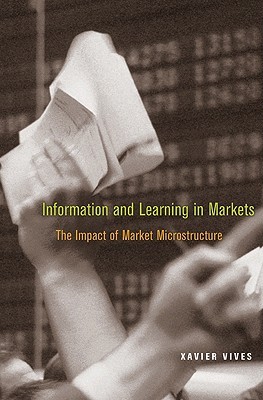
- We will send in 10–14 business days.
- Author: Xavier Vives
- Publisher: Princeton University Press
- ISBN-10: 0691145962
- ISBN-13: 9780691145969
- Format: 14.2 x 22.6 x 2.5 cm, softcover
- Language: English
- SAVE -10% with code: EXTRA
Reviews
Description
The ways financial analysts, traders, and other specialists use information and learn from each other are of fundamental importance to understanding how markets work and prices are set. This graduate-level textbook analyzes how markets aggregate information and examines the impacts of specific market arrangements--or microstructure--on the aggregation process and overall performance of financial markets. Xavier Vives bridges the gap between the two primary views of markets--informational efficiency and herding--and uses a coherent game-theoretic framework to bring together the latest results from the rational expectations and herding literatures.
Vives emphasizes the consequences of market interaction and social learning for informational and economic efficiency. He looks closely at information aggregation mechanisms, progressing from simple to complex environments: from static to dynamic models; from competitive to strategic agents; and from simple market strategies such as noncontingent orders or quantities to complex ones like price contingent orders or demand schedules. Vives finds that contending theories like informational efficiency and herding build on the same principles of Bayesian decision making and that "irrational" agents are not needed to explain herding behavior, booms, and crashes. As this book shows, the microstructure of a market is the crucial factor in the informational efficiency of prices.- Provides the most complete analysis of the ways markets aggregate information
- Bridges the gap between the rational expectations and herding literatures
- Includes exercises with solutions
- Serves both as a graduate textbook and a resource for researchers, including financial analysts
EXTRA 10 % discount with code: EXTRA
The promotion ends in 17d.11:08:41
The discount code is valid when purchasing from 10 €. Discounts do not stack.
- Author: Xavier Vives
- Publisher: Princeton University Press
- ISBN-10: 0691145962
- ISBN-13: 9780691145969
- Format: 14.2 x 22.6 x 2.5 cm, softcover
- Language: English English
The ways financial analysts, traders, and other specialists use information and learn from each other are of fundamental importance to understanding how markets work and prices are set. This graduate-level textbook analyzes how markets aggregate information and examines the impacts of specific market arrangements--or microstructure--on the aggregation process and overall performance of financial markets. Xavier Vives bridges the gap between the two primary views of markets--informational efficiency and herding--and uses a coherent game-theoretic framework to bring together the latest results from the rational expectations and herding literatures.
Vives emphasizes the consequences of market interaction and social learning for informational and economic efficiency. He looks closely at information aggregation mechanisms, progressing from simple to complex environments: from static to dynamic models; from competitive to strategic agents; and from simple market strategies such as noncontingent orders or quantities to complex ones like price contingent orders or demand schedules. Vives finds that contending theories like informational efficiency and herding build on the same principles of Bayesian decision making and that "irrational" agents are not needed to explain herding behavior, booms, and crashes. As this book shows, the microstructure of a market is the crucial factor in the informational efficiency of prices.- Provides the most complete analysis of the ways markets aggregate information
- Bridges the gap between the rational expectations and herding literatures
- Includes exercises with solutions
- Serves both as a graduate textbook and a resource for researchers, including financial analysts


Reviews